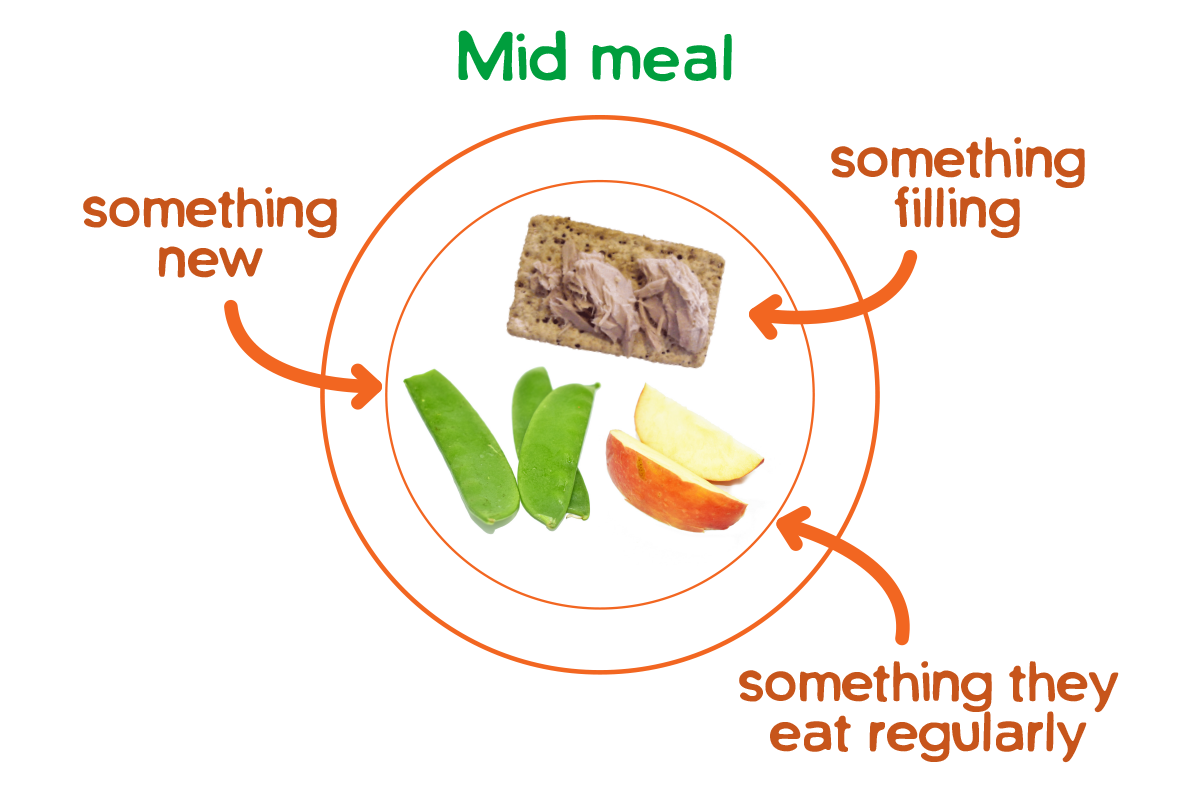Which foods to provide
Summary
- We need to consider ‘HOW’ to feed alongside ‘WHAT’ to feed.
- The Australian Dietary Guidelines provides information on which foods to provide. Meeting the guidelines is up to them.
- Children are more like to meet guidelines over a longer period than a day.
- Provide familiar foods alongside new foods at meals.
- It’s your child’s job to decide whether to eat, how much to eat and what they eat from the plate.
On this page
It’s important that children learn to like eating and eat foods they like.
Nutrition for children
On this page we look at the food that will provide our children with the nutrition they need to grow and develop. But first things first. You need to make sure you are considering the challenges your child has to overcome, before they can safely and happily accept new foods and eat a varied diet.
In PICNIC we have purposefully kept the information on the vitamins and minerals to a minimum.
We keep it simple and talk about foods, variety between the food groups and then increasing variety within food groups. If children are provided a regular supply of food from the 5 food groups in an acceptable form, they will get the nutrition they need.
Your child is learning to eat what you eat
The recommendations for children are fairly similar to the recommendations for adults, just in smaller amounts. You can all choose to eat foods from the same selection of food. Over time their eating will look more like your eating.

There are some things you need to consider as they are still working on their eating skills. Your child will look to you for guidance in everything they do. Being a role model is important.
Remember your feeding roles when feeding your child. You are responsible for the What, Where and When food is provided, and your child is responsible for whether they will eat and how much.

Australian Dietary Guidelines for 3-6 years
This section guides you on the foods to PROVIDE children over a day, not what they ‘SHOULD EAT’
After serving, leave them to learn, explore and become familiar with foods without any pressure




 The Eat for Health Website provides more detail about the five food groups including the recommended servings for age.
The Eat for Health Website provides more detail about the five food groups including the recommended servings for age.
You can provide these foods, but it is up to your child to meet the guidelines.
There are lots of meal planning and snack ideas online, including the page First Steps Nutrition UK. Remember there are no magic meals or recipes that your child will automatically eat. It will be just offering and letting them learn new foods on their terms.
Mid Meals
Mid meals are an important part of a child’s eating and should be treated in the same way as main meals. They might be hungrier at a mid-meal than the main meal. A mid-meal could be a combination of fruits, vegetables, meat, fish, beans, eggs, breads/cereals and nut butters.

Make sure we all stop for the mid meal, it doesn’t have to be at a table, as long as it becomes eating time, without other distractions. Don’t allow your child to eat on the run or eat while doing other activities. If your child is hungry at a non-meal or snack time, offer water and let them know their next meal/snack is not far off.
Progressing food texture safely
Your child will be still learning to manage different textures safely and therefore they are likely to gag on textures they are still learning to manage. and are still at risk of choking. The progressing food texture safely page located within the 6-12 months section, provides guidance on how to make foods safer for your toddler and foods to avoid. 
Your child’s drinks
Between meals, provide water or breastfeed. Your child should be drinking fluids (water, full fat milk) from a cup. There is no need for any ‘follow on’ toddler formula. The nutrients in these formulas can be provided by solid food, even if it seems they aren’t eating much.
Soy, goat, sheep, coconut and almond milk are not good alternatives to dairy or breast milk.
Avoid giving soft drinks, flavoured water (cordial), juice, energy drinks or sports drinks as these are high in sugar and don’t provide much nutrition to your growing toddler. These drinks can lead to fussy or problem eating and dental issues.

Tips for providing foods for children
At each meal provide enough filling foods so your toddler can leave the meal satisfied. You will never know if they will be hungrier at morning tea, lunchtime or afternoon tea. You just can’t plan it. They will always surprise you.

Provide a couple of foods that your child has eaten before at each meal. If they recognise a food, it can make them braver with new foods they haven’t learned to like yet. A mixture of accepted foods and new foods will help your child increase variety in their diet.
You can’t influence their eating once served but you can try new ways to provide foods.
You can change the time of day you serve foods. If they eat better at certain time of the day, you might use this time to provide food your child finds more challenging and they’re taking a bit longer to accept and like.

You can change how rejected foods are served to see it helps them to taste and eventually like the food. This might be serving foods raw or cooked, sliced, diced, peeled, cubed, grated or even fancy shapes if you have the time! You can change which foods are served together or spread foods out on the plate, so they are easier to recognise.
Even after lots of ‘trying new ways’ to serve food, acceptance and increase in diet variety might be slow. Be prepared to play the long game and variety will increase if we don’t pressure.
Vegan and vegetarian diets
Vegetarian and especially vegan diets come with a higher risk of our child not getting enough iron due to low intakes of animal foods. If you are choosing a vegan diet for your child, it is recommended that you see a Dietitian to make sure you are providing the right nutrition for your toddler and advice on iron and B12 supplementation.
This fact sheet from the Royal Children Hospital Melbourne provides more information on vegetarian diets for children.

- Satter E. Eating Competence: Definition and Evidence for the Satter Eating Competence Model. Journal of Nutrition Education and Behavior. 2007;39(5, Supplement):S142-S53.
- (NHMRC). NHaMRC. Eat for Health: Australian Dietary Guidelines;. In: Ageing DoHa, editor.: Canberra, Australia, ; 2013.

